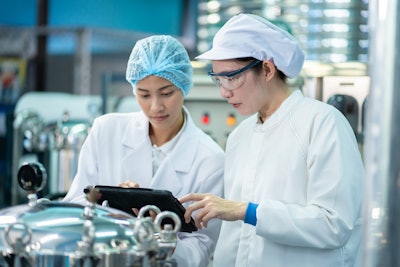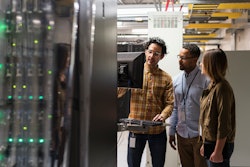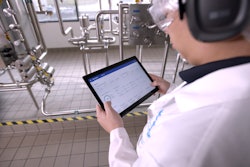Artificial Intelligence (AI) has been used in food processing for many years to improve efficiency, food quality, and food safety. AI applications are used in predictive maintenance and supply chain applications to enhance manufacturing operations.
While AI technologies like optical sorting, robotic pick and place, and data collection software have been used in food manufacturing in recent years, this article addresses the latest AI uses such as the creation of targeted training programs, production planning and shift capacity analysis, and queries to existing databases to identify opportunities for yield improvement.
To learn more about actual AI applications, FSO Institute interviewed Scott Spencer for his cutting-edge experience in implementing AI in food and beverage manufacturing. Spencer has more than 25 years of experience in the food, beverage, and nutraceutical industries with positions at General Mills, Snyder’s-Lance, and Nature’s Bounty. In his most recent past role as president and COO of Island Abbey Foods, Spencer drove improvements in performance management systems, multiple capacity expansions, and commercial growth.
Spencer has been at the forefront of implementing AI tools across three key areas: employee training, production planning/scheduling, and yield optimization.
FSO Institute: How is the food manufacturing industry engaging in AI?
Spencer: The pace of AI advancement is like no technology we have ever seen before. We’re just scratching the surface of what AI can do for food manufacturers. In 2023, AI was primarily focused on text and still pictures. Now, AI can create videos and audio tracks based on simple text prompts. AI advances over the last few years have been staggering, and they are transforming nearly every aspect of operations.
FSO Institute: What is one of the greatest food manufacturing challenges AI can help solve?
Spencer: Food manufacturing has perpetually struggled with high employee turnover, making training an endless cycle of repetitive efforts. With AI, this constant training burden can be minimized.
In the past, technical experts and experienced operators created new employee training from scratch based on technical manuals and experience in company procedures. Now, AI can digest huge volumes of technical and company policies, incorporate them into one database, and create standardized and customized training in minutes. Once verified by experienced operators and the technical team, training can be rolled out in hours. For example, an OEM’s operating manual can be uploaded to a large language model (LLM), and both SOP and training modules can be created in an instant. A simple prompt such as, “Write an SOP and training on the startup of a piece of equipment” will produce a detailed SOP and an outline of the SOP training document. After adding a few pictures for clarity and verifying accuracy, the company now has a detailed SOP and training on the equipment startup process.
FSO Institute: Can training applications go beyond generic training modules?
Spencer: Without a doubt. There are two applications I have recently experienced. In the first, along with an equipment technical manual, the organization uploaded the company’s safety and quality manuals and procedures into an LLM. Now the AI has company policies along with the equipment technical specification. This can be used to generate training specific to the company very similar to a generic module. It just has more data to utilize.
Secondly, one item often missing from company training modules is interactivity. Information is presented to the trainee and, if it’s good, there is a test or hands-on demonstration for the trainee to exhibit the skills acquired. AI can also quickly generate testing and human and organizational development tools for trainers to use in verifying the trainee skills required. However, that’s just the start.
In AI-based training, the trainee can query the AI system when they have questions not covered by the training. The trainee can ask, “What material is this part made of?” or “What maintenance is recommended on this equipment?” In addition, AI can address different trainee skillsets. For example, the trainee can prompt the AI to explain a topic at a different level or from a different perspective. This tailors the experience to each user to ensure the training is at the appropriate skill level for that individual.
FSO Institute: What other food industry applications can successfully use AI?
Spencer: AI is also streamlining complex scheduling and production planning efforts. Optimizing labor allocation and machine utilization is a massive data challenge that’s perfect for AI.
Most companies have relied on rudimentary staffing projections based on historical shifts, rough equipment calculations, and product demand best guesses. In contrast, AI applications can analyze real-time manufacturing data, sales trends, supplier statuses, equipment efficiency, and more to create optimized staffing and run schedules down to 15-minute intervals.
AI considers countless variables and possibilities that human planners can’t feasibly process. With this level of intelligent scheduling, manufacturers are consistently hitting peak efficiencies.
By mapping out an idealized plan for staffing levels, material flow, equipment usage, and inventory needs, AI eliminates production bottlenecks, minimizes downtime, and synchronizes the full manufacturing process. This allows proactive staffing adjustments, line rebalancing, and precise coordination with maintenance teams to keep productivity on track.
AI takes the guesswork out of production planning, creating more throughput, less waste, and better control of costs.
FSO Institute: How can AI help manufacturers improve yield?
Spencer: AI solutions can extract valuable insights from existing manufacturing data repositories. The goal is to identify hidden factors and relationships that impact yields, product quality, and material losses.
Food manufacturers are sitting on mountains of data from machine sensors, batch records, material tests, and even manual logs from operators. But very few have the bandwidth to analyze all these sources simultaneously and translate them into actionable intelligence.
That’s where AI’s advanced data mining and pattern recognition capabilities come into play. By ingesting all available data, AI can isolate key variables linked to yields and product quality metrics, finding factors no one even thought to consider. AI might determine that humidity levels three days prior combined with a specific presser setting correspond directly with higher defect rates.
With these insights, manufacturers can make informed process adjustments, predictive maintenance schedules, supplier changes, or other systematic improvements to chip away at losses and optimize yields. AI continuously monitors data streams for emerging patterns, by learning and refining its analysis in a constant pursuit of enhanced efficiency and quality assurance.
Companies have experienced massive yield improvements leveraging existing data and AI. For high-volume food producers, that’s millions of dollars in recaptured revenue from reduced waste and improved throughput.
FSO Institute: What’s next for AI?
Spencer: I’d predict three major areas of advancement: individual productivity, interactive data analysis, and robotics.
Individual productivity is often the first use case a company can deploy. There are cloud-based AI systems that will record your video conference call, summarize the key topics, and publish thorough notes. This is just one example of personal productivity. AI can be used to answer emails, summarize contracts, digest large amounts of text or data, and present them in the format the user desires. This supports speed to decision-making and alleviates time-wasting from any decision-maker’s job.
People often forget about AI’s interactive capabilities. As I mentioned in the training and yield examples, AI can interact, educate, and provide insights to data and present them in different formats. Eventually, AI agents will be able to make a recommendation or act on its own based on data. The days of dashboard data are numbered, in my opinion. In the next year or so, you will be able to query an AI database with any question that might be applicable.
For example, you may have vibration monitors on hundreds of motors in your plant. This is a common predictive maintenance technique to identify bearing wear or other issues with pumps. Currently, this data is typically presented in a dashboard that a human monitors. When a motor vibration gets to a certain point, it is scheduled for replacement or maintenance. Then a user could type into an AI-monitored database, “Do I have any motors that are nearing the vibration threshold?” Instead of interpreting a graph to make a decision, AI presents you with that data. The next step with AI agents is for the AI to identify an issue with a motor and then schedule the maintenance automatically—without human intervention.
Finally, and I think what people fear the most, is the pairing of AI with advanced robotics strides. There is no doubt that manual labor will soon be replaced by robotics leveraging advanced AI learning capabilities. To what extent, we don’t know. But it is coming.




















